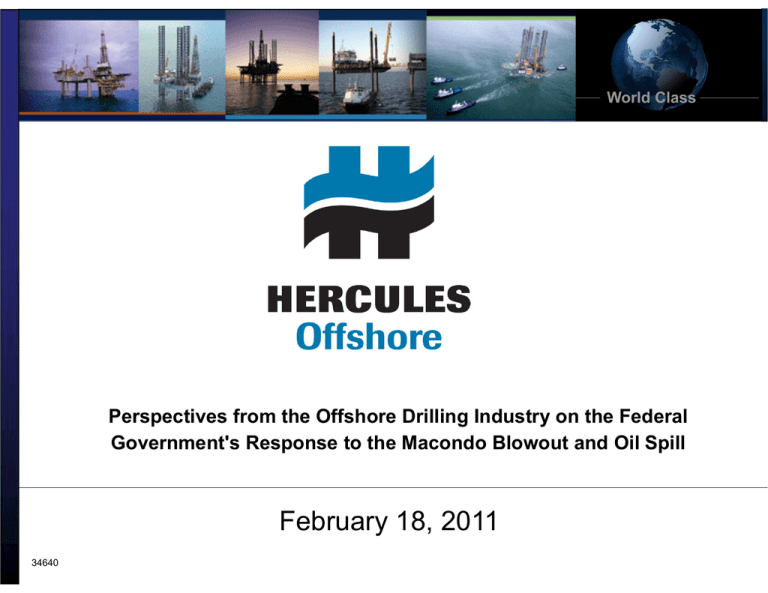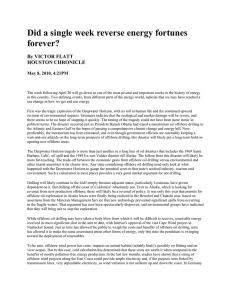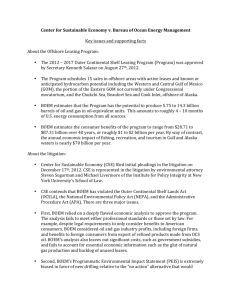Perspectives from the Offshore Drilling Industry on the Federal
advertisement

World Class Perspectives from the Offshore Drilling Industry on the Federal Government's Response to the Macondo Blowout and Oil Spill February 18, 2011 34640 World Class A Brief History of Offshore Drilling in Gulf of Mexico A Brief History of Offshore Drilling 1930’s – Texaco and Shell deployed moveable barges to drilling South Louisiana marshes 1938 – Pure Oil and Superior Oil along with Brown & Root built first freestanding structure offshore Gulf of Mexico in 14 ft. of water March 1938 Mexico nationalized its oil industry, establishing the precedent that would dominate the modern oil and gas industry Standard Oil of California (later Chevron) completed first discovery well in Saudi Arabia Still greatest oil find ever First production of offshore oil in Gulf of Mexico 2 World Class A Brief History of Offshore Drilling (Cont’d.) August 14, 1945 – day after Japanese surrender in W.W.II, U.S. lifted oil and gasoline rations Post-W.W. II – conversion of war-surplus landing crafts converted to drilling tenders, supply and crewboats 1948 – Kerr-McGee Oil Industries – drilled first productive “out-of-sight-of land” well on platform in 18 ft. of water Kerr-McGee 16 platform – converted war-surplus tender barge 1948 – Humble Oil (later Exxon) introduced forerunner of modern platform design Early 1950’s –Zapata Offshore (formed by George H.W. Bush) experimented with “jackup” rigs 3 World Class A Brief History of Offshore Drilling (Cont’d.) 1954 – First OCS lease sale 1957 – 446 production platforms January 28, 1969 – Union Oil platform blowout in Santa Barbara Channel, 80,000-100,000 barrels spilled Led to passage of National Environmental Policy Act Nixon administration issues moratorium on drilling in California Amended OCS orders establishing requirements for plans and equipment for prevention of pollution and blowouts 1981 – Shell produces first platform in 1,000 feet of water 1982 – Minerals Management Service created 1994 - Shell’s production in 2,860 feet of water using tension-leg platform 1996 – First production from deepwater spar 1999 – BP’s Thunder House produces in 6,000 feet of water 4 World Class A Brief History of Offshore Drilling (Cont’d.) 46,011 wells drilled in less than 1,000 feet of water since 1949 BOEM records 11,070 wells drilled in less than 500 feet of water in last 15 years1 BOEM Records: Total of 15 barrels of oil spilled in last 15 years1 Actual worst case spill – March 8, 2003 spill offshore Louisiana resulting in 10 barrels of oil spilled (1) Source: BOEM; http://www.gomr.mms.gov – see appendix. 5 World Class Shallow Water and Deep Water Drilling World Class 5 3 Floating Factories World Class 6 10 Strong Safety Record For Oil & Gas Extraction Oil & Gas Industry Shows Culture of Safety Veterinary services Grocery stores Tortilla manufacturing Department stores Libraries and archives Child day care services Oil and gas extraction Commercial banking Insurance carriers Certified public accountants 0.0x 1.0x 2.0x 3.0x 4.0x 5.0x 6.0x 7.0x 8.0x 9.0x Sample listing of selected industry groups in relation to the injury rate of oil & gas extraction According to the Bureau of Labor Statistics, oil & gas extraction has a lower injury rate than 89% of the total 134 million working Americans based on industry groups Source: Bureau of Labor Statistics - 2008 incidence rates of nonfatal occupational injuries and illnesses http://www.bls.gov/iif/oshwc/osh/os/ostb2071.pdf 8 World Class Exodus of Rigs • Since 2001, approximately 78 Jackups have left the U.S. Gulf of Mexico – leaving 44 available shallow water rigs • Since the moratorium began on May 6, 2010, five jackup rigs have announced they will leave the Gulf of Mexico. • 14 total rigs (Shallow and Deep) have left, and many others have been mothballed Europe: 1 Canada: 2 Med./Black Sea: 9 Mid East: 29 SE Asia 4 Mexico / C. Amer: 14 W Africa: 5 India: 4 S. Amer: 5 9 World Class 9 OCS – Dominated By Independents • 284 Independent operators accounted for 73% of total production on Gulf of Mexico shelf in 2009 Percentage of Total Production in US GOM shelf (<500ft) 27% Majors • 293 companies produced 234 MMBOE on the GOM shelf (<500’) during 2009 73% Independents 10 World Class 10 “Big Oil” Operators Not Dependent on U.S. GOM • Major operators can redirect investment to large existing assets outside of GOM • Smaller independent GOM operators have a large majority of their assets in the US, and many have 100% of assets in US Gulf of Mexico US GOM Crude Oil Production as a Percentage of Worldwide Crude Oil Production 100% 80% 60% 40% 20% 0% BP Chevron GOM Production Exxon Shell International Production 11 World Class 11 Offshore Leasing Activity • From 2001 through 2009, the U.S. Gulf of Mexico has generated a total of $75 billion in federal royalty revenue and lease sale proceeds • $60 billion in federal royalty payments • That’s equivalent to the economy of Nebraska • $15 billion in proceeds from offshore lease sales • The lack of lease sales and royalty revenue is costing taxpayers money and adding to the national debt. US GOM OCS Royalty Revenues and Lease Sales Proceeds (2001 – 2009 Cumulative) Lease Sales $15 B Royalties $60 B 12 World Class 12 Oil and Gasoline Prices Crude Oil Prices Gasoline Prices $3.500 90.00 $3.300 $3.100 80.00 $2.900 $2.700 70.00 $2.500 $2.300 60.00 $2.100 50.00 $1.900 $1.700 40.00 Qtr1 Qtr2 Qtr3 Qtr4 Qtr1 Qtr2 Qtr3 Qtr4 Qtr1 $1.500 Qtr1 2009 2010 Qtr2 Qtr3 Qtr4 Qtr1 Qtr2 Qtr3 Qtr4 Qtr1 2011 2009 2010 2011 Crude oil and retail gasoline prices are at their highest levels in over 2 years 13 World Class World Class The Post-Macondo World Energy Security is National Security • The United States already imports oil from a host of nations whose governments or people are hostile to our interests or unstable – or both. • Recently, Cuba announced plans to drill 7 test wells in the Gulf of Mexico, with drilling assistance from China. • China’s national oil company has invested approximately $1.8B to acquire interests in 1.4M acres in Texas, Wyoming, and Colorado • Intensifying instability in the Middle East threatening supply. Oil-Producing Nations outside of North America US Crude Oil Imports November 2010 (1000 bpd) Saudi Arabia 1,119 Venezuela 884 Nigeria 806 Colombia 489 Algeria 379 Iraq 340 Angola 263 Over 48% of U.S. crude oil imports come from OPEC countries 15 World Class 15 Post Macondo Timeline • April 20, 2010: Tragedy at Macondo well • May 6, 2010: U.S. Department of Interior (DOI) declared a moratorium on all new drilling permits • May 7, 2010: Shallow Water Energy Security Coalition (SWESC) led by Hercules Offshore was created to educate policymakers on differences between shallow and deepwater drilling • May 19, 2010: MMS is replaced with Bureau of Ocean Energy Management, Regulations and Enforcement (BOEM), Bureau of Ocean Energy Management and Office of Natural Resources Revenue. Director of the MMS resigns. • May 21, 2010: SWESC obtained signatures from 66 members of Congress urging DOI Secretary Salazar to lift moratorium on shallow water drilling operations • May 26, 2010: SWESC met with DOI Secretary Salazar • May 28, 2010: Shallow water drilling moratorium is lifted, but deepwater drilling moratorium extended for six months • May 31, 2010: BOEM confirmed approval of two shallow water drilling permits, both of which were revoked shortly thereafter • June 8, 2010: NTL 05 issued by the BOEM outlining the first round of new safety regulations including CEO certification of equipment and third-party verification and reviews • June 18, 2010: NTL 06 issued by the BOEM requiring operators to include blowout scenarios in all new drilling permit applications • September 30, 2010: DOI announces “new” Drilling Safety Rule and Workplace Safety Rule • November 8, 2010: NTL 2010-N10 issued by BOEM for subsea BOP or surface BOP’s on floating facilities • February, 2011: Only 31 permits have been approved for the drilling of new wells1 1. BOEM as of February 16, 2011 16 World Class 16 Shallow Water Permitting Activity: the de facto Moratorium U.S. GOM Shallow Water Total Permits Approval History (1) 40 38 36 36 35 32 # of Approved Permits 29 28 30 27 25 26 26 21 19 20 17 15 15 15 10 26 24 22 22 27 12 11 12 Aug Sep 14 7 5 5 2 0 Jan Feb Mar Apr May 3-Year Avg (07-09) Jun Jul 2010 Oct Nov Dec 2011 The number of approved drilling permits is down by roughly half since imposition of new regulations in June 2010 Only 12 permits issued in Year-to-Date through mid-February 2011 (1) Source: Bureau of Ocean Energy Management, Regulation and Enforcement as of February 14, 2011 17 World Class Administration Response: Arbitrary and Capricious Overly broad, economically devastating moratorium imposed No economic impact analyses conducted No evaluation of energy security No scientific or expert support for need or advisability of moratorium Secretary Salazar: “. . . The recommendations contained in this report have been peer-reviewed by seven experts identified by the National Academy of Engineering.” May 27, 2010 Report of Secretary Ken Salazar to President Obama Judge Feldman, E.D. of LA: “. . . This statement was misleading.” “Factually incorrect.” 18 World Class Administration Response: Arbitrary and Capricious (Cont’d.) Administration failed to consider the “irreparable harm” that would result Economic Cultural Administration failed to explain reason for sweeping scope of moratorium Violated OCSLA Mandates consideration of the “economic, social, and environmental values of the renewable and nonrenewable resources of the Outer Continental Shelf . . .” 43 U.S.C. §1344(a)(1) Allows Secretary of Interior to suspend activity “if there is a threat of serious, irreparable, or immediate harm or damage to life (including fish or other aquatic life), to property, to any mineral deposits . . . or to the marine, coastal, or human environment . . .” 46 U.S.C. § 1334(a)(1). Judge Feldman: “The defendants have failed to cogently reflect the decision to issue a blanket, generic, indeed punitive, moratorium with the facts developed … The plaintiffs have established … that the Administration acted arbitrarily and capriciously in issuing the moratorium.” 19 World Class Administration’s Usurpation of Legislative Power Notice and comment procedure required before enactment of “substantive” or “legislative” rules that “create law.” Nat’l Family Planning & Reprod. Health Ass’n v. Sullivan, 797 F.2d 227, 237 (D.C. Cir. 1992) June 8, 2010 – Dept. of Interior issues Notice to Lessee 2010-N.05 (“NTL 05”) Requires lessees and operators to obtain 5 separate 3rd-party verifications and certifications “Must” have independent 3rd-party conduct detailed physical inspection of BOP’s Imposes new requirements on remote operated vehicles Mandates new equipment Secondary control system with remote operated vehicle capabilities October 19, 2010 – Federal court invalidates NTL-05 due to failure of Dept. of Interior to follow notice and comment procedures Agency attempted to make law - by fiat 20 World Class Administration’s Defiance of Judicial Authority May 28, 2010 – Moratorium imposed June 22, 2010 – Federal Court enjoins Dept. of Interior form enforcing moratorium June 22, 2010 – Secretary Salazar issues press release stating his decision to “impose a moratorium on deepwater drilling was and is the right decision.” July 8, 2010 – U.S. Ct. of Appeals for 5th Circuit rejected government’s plea to stay enforcement of District Court’s injunction July 12, 2010 – Secretary Salazar “rescinds” moratorium and issues new, identical moratorium October 12, 2010 – Second moratorium lifted February 2, 2011 – Federal Court holds Secretary Salazar in contempt, orders payment of attorneys fees 21 World Class How Has World Changed? 1st – Change in tone CEO Certifications of regulatory compliance Investigations and review unit at BOEMRE “Boot on neck” – Secretary Salazar “Someone’s ass to kick” – President Obama 2nd – Dynamic - and not so dynamic - regulatory environment Drilling safety rule De facto moratorium/slow permitting Workplace safety rule Cancelled/suspended lease sales 22 World Class Tone Matters Priorities: “…in one of my first acts as Director, I created a new investigations and review unit within BOEM that will help us…rein in companies that attempt to game the system.” – Director Michael Bromwich On the investigations and review unit: “A team of professionals, with law enforcement backgrounds…” BOEM Website On CEO Certifications: “This brings a new level of personal, executive accountability to the deepwater drilling industry.” – Director Michael Bromwich On de facto moratorium: “[de facto moratorium]…is code used by some segments of … industry for the added time it takes to ensure compliance with tougher safety rules…” – Director Michael Bromwich 23 World Class What Do We Want? Collaborative, respective relationship between industry and regulators Risk-based, fact-based, science-based regulations and treatment Industry voice on development of regulations – “trust, but verify” Regulatory certainty and coherent and fair process for development of new rules and regulations – due process of law Apolitical regulatory approach 24 World Class What We Need To Do As An Industry? Continued industry-wide, collaborative efforts to address well control and oil spill containment and cleanup Marine Well Containment Corporation – model Continued advancement of behavioral-based safety training programs Continued engagement with administration and lawmakers Represent the industry in media – tell our story Advocate for comprehensive energy policy Identify ways to strengthen regulatory community or establish intra-industry regulatory approach 25 World Class World Class



